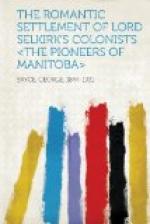The house still stands a stained and battered memorial of a past generation. But on this October morning, of an Indian summer day, the air was so soft, that it seemed to smell wooingly here, and through the gentle haze, was to be seen sitting on his verandah, the patriarch of the village, who was as well the genius of the place.
The old man had a fine gray head with the locks very thin, and with his form, not tall but broad and comfortable to look upon, he occupied an easy chair.
The writer was then quite a young man fresh from College, and with a simple introduction, after the easy manner of Western Canada, proceeded to hear the story of old Andrew McDermott, the patriarch of Winnipeg.
“Yes,” said Mr. McDermott, “I was among those of the first year of Lord Selkirk’s immigrants. We landed from the Old Country, at York Factory, on Hudson Bay. The first immigrants reached the banks of the Red River in the year 1812.
“I am a native of Ireland and embarked with Owen Keveny—a bright Hibernian—a clever writer, and speaker, who, poor fellow, was killed by the rival Fur Company, and whose murderer, De Reinhard, was tried at Quebec. Of course the greater number of Lord Selkirk’s settlers were Scotchmen, but I have always lived with them, known them, and find that they trust me rather more than they at times trust each other. I have been their merchant, contractor, treaty-maker, business manager, counsellor, adviser, and confidential friend.”
“But,” said the writer, “as having come to cast in my lot with the people of the Red River, I should be glad to hear from you about the early times, and especially of the earlier people of this region, who lived their lives, and came and went, before the arrival of Lord Selkirk’s settlers in 1812.” Thus the story-telling began, and patriarch and questioner made out from one source and another the whole story of the predecessors of the Selkirk Colonists.
[Illustration: Mound builders’
ornaments, etc.
A. Ornamental gorget of turtle’s plastron.
B. Gorget of sea-shell (1879).
C. Gorget of buffalo bone.
D. Breast or arm ornament of very hard bone.
E. String of beads of birds’ leg bones.
Note cross X.
F. One of three polished stones used for gaming.
G. Columella of large sea couch (tropical, used as
sinker for fishing).]
AN EXTINCT RACE.
“Long before the coming of the settler, there lived a race who have now entirely disappeared. Not very far from the Assiniboine River, where Main Street crosses it, is now to be seen,” said the narrator, “Fort Garry—a fine castellated structure with stone walls and substantial bastions. A little north of this you may have noticed a round mound, forty feet across. We opened this mound on one occasion, and found it to contain a number of human skeletons and articles of various kinds.




